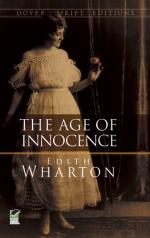Forty-eight hours later the unbelievable had happened; every one had refused the Mingotts’ invitation except the Beauforts and old Mr. Jackson and his sister. The intended slight was emphasised by the fact that even the Reggie Chiverses, who were of the Mingott clan, were among those inflicting it; and by the uniform wording of the notes, in all of which the writers “regretted that they were unable to accept,” without the mitigating plea of a “previous engagement” that ordinary courtesy prescribed.
New York society was, in those days, far too small, and too scant in its resources, for every one in it (including livery-stable-keepers, butlers and cooks) not to know exactly on which evenings people were free; and it was thus possible for the recipients of Mrs. Lovell Mingott’s invitations to make cruelly clear their determination not to meet the Countess Olenska.
The blow was unexpected; but the Mingotts, as their way was, met it gallantly. Mrs. Lovell Mingott confided the case to Mrs. Welland, who confided it to Newland Archer; who, aflame at the outrage, appealed passionately and authoritatively to his mother; who, after a painful period of inward resistance and outward temporising, succumbed to his instances (as she always did), and immediately embracing his cause with an energy redoubled by her previous hesitations, put on her grey velvet bonnet and said: “I’ll go and see Louisa van der Luyden.”
The New York of Newland Archer’s day was a small and slippery pyramid, in which, as yet, hardly a fissure had been made or a foothold gained. At its base was a firm foundation of what Mrs. Archer called “plain people”; an honourable but obscure majority of respectable families who (as in the case of the Spicers or the Leffertses or the Jacksons) had been raised above their level by marriage with one of the ruling clans. People, Mrs. Archer always said, were not as particular as they used to be; and with old Catherine Spicer ruling one end of Fifth Avenue, and Julius Beaufort the other, you couldn’t expect the old traditions to last much longer.
Firmly narrowing upward from this wealthy but inconspicuous substratum was the compact and dominant group which the Mingotts, Newlands, Chiverses and Mansons so actively represented. Most people imagined them to be the very apex of the pyramid; but they themselves (at least those of Mrs. Archer’s generation) were aware that, in the eyes of the professional genealogist, only a still smaller number of families could lay claim to that eminence.
“Don’t tell me,” Mrs. Archer would say to her children, “all this modern newspaper rubbish about a New York aristocracy. If there is one, neither the Mingotts nor the Mansons belong to it; no, nor the Newlands or the Chiverses either. Our grandfathers and great-grandfathers were just respectable English or Dutch merchants, who came to the colonies to make their fortune, and stayed here because they did so well. One of your great-grandfathers signed the Declaration, and another was a general on Washington’s staff, and received General Burgoyne’s sword after the battle of Saratoga. These are things to be proud of, but they have nothing to do with rank or class. New York has always been a commercial community, and there are not more than three families in it who can claim an aristocratic origin in the real sense of the word.”




